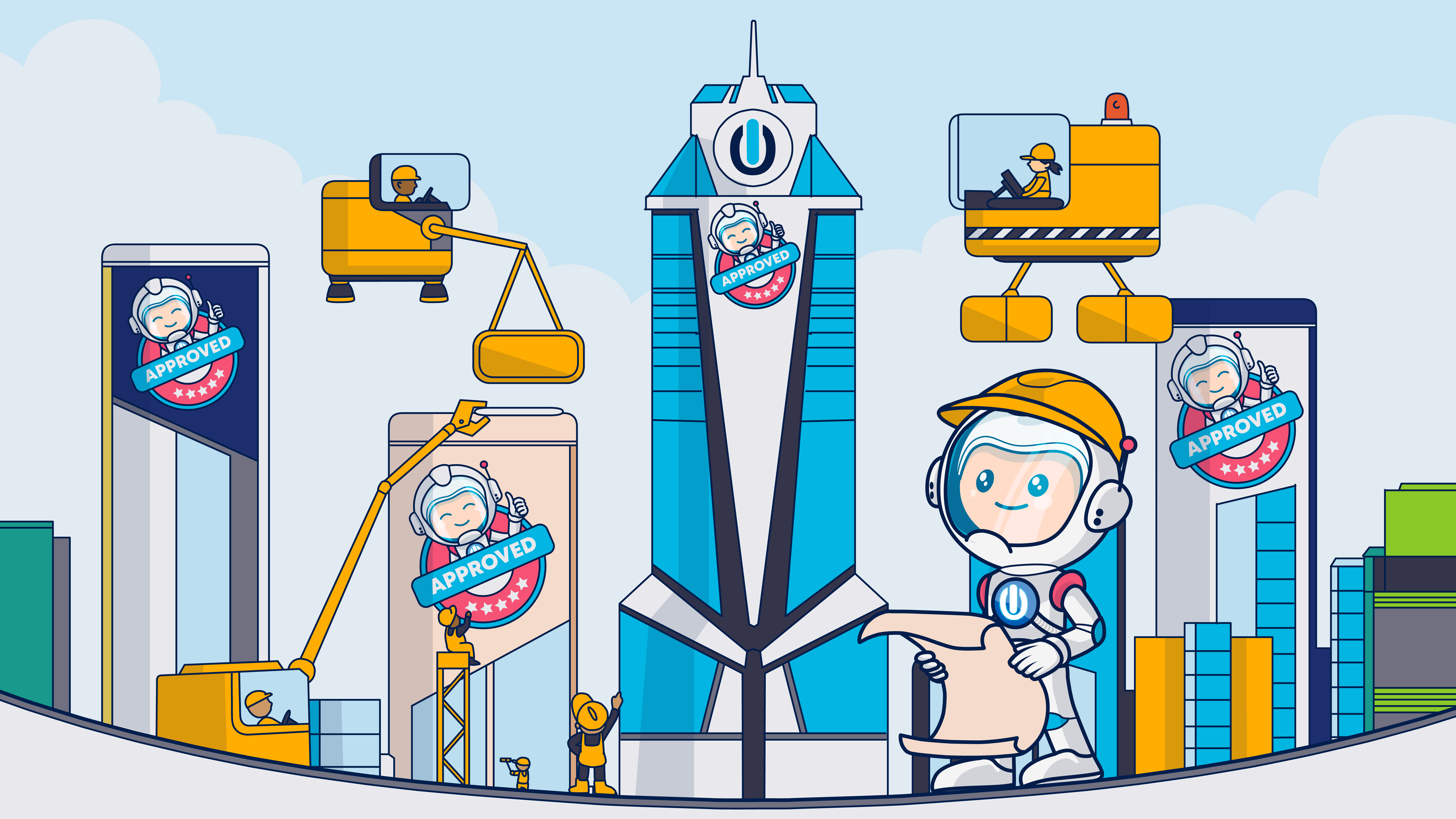A powerful acquisition process is an excellent start toward growing your business, but it isn’t enough to ensure long-term success. That’s why growth marketing directs equal attention to every stage in the customer journey, from awareness to advocacy. Accelerate your company’s growth engine with this guide to building outstanding onboarding emails that assure their journey from interest to adoption is fast and frictionless.
You know what I call a success?
A company that’s been around for nearly a century, has nearly universal appeal, and for which the mention of the name alone brings back fond childhood memories for people around the world.
Now that’s a brand that has mastered the art of activation and loyalty.
Lego celebrated its 90th anniversary in 2022. That’s 90 years of appealing to children’s imaginations “and developing the creative urge and joy of creation that are the driving force in every human being.”
Can you tell I’m a fan? There’s no doubt that the Lego product concept has a lot to do with the brand’s long-lived success. But there’s more to it than that. Lego built a legacy by ensuring that every child (or adult) who encountered its toys could enjoy their toy.
Lego accomplished this not only by creating a toy for which open-ended play was a delight but also by offering detailed guidance that taught new users, step by step, how to become better at using the toy.
The instructions for these creative building toys are legendary in their precision and detail. Even for the brand’s largest building sets, the instructions still deliver bite-sized guidance so that users experience consistent, progressive success.
It’s UX artistry.
Other brands can learn a lot from how Lego has pursued continual improvement of its customers’ experiences.
Today’s instructions are available online and users can find video tutorials to walk them through building everything from simple objects to complex, multi-part designs.
How does your onboarding process compare?
Does it deliver success in easy, bite-sized pieces? Does it guide users to discover that aha moment that converts them into loyal customers via automated emails?
Emails are a fast and effective way to deliver onboarding content that accelerates activation, encourages habit forming, and increases retention. How can your onboarding emails accomplish all this and more?
I’ve created this guide to show you.
What are onboarding emails and how do they support customers’ experiences?
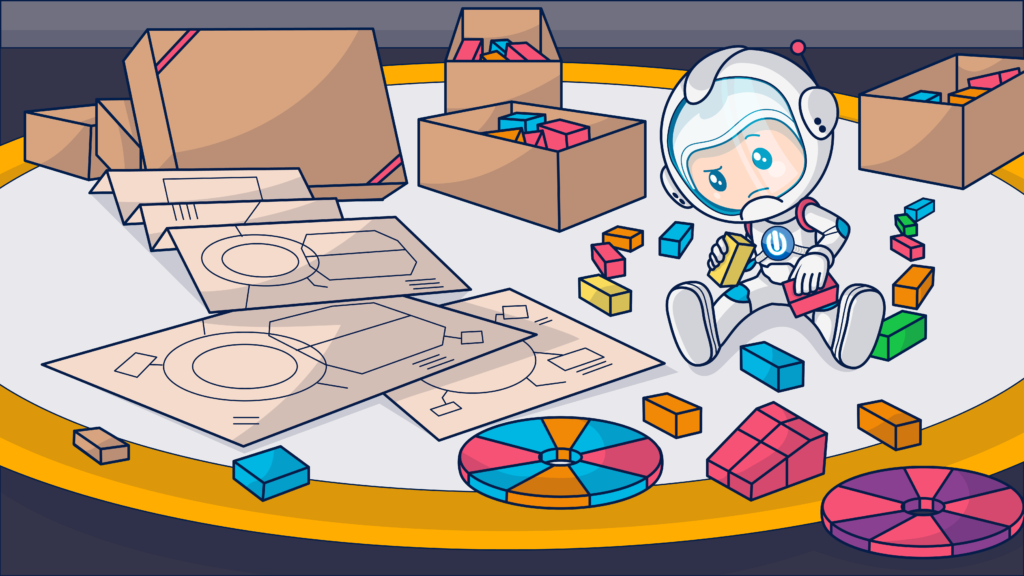
Onboarding emails are an onboarding tool that enables companies to reach new users or customers with valuable information to maintain their interest in the brand’s physical or digital product or service and keep them moving forward on their customer journeys.
Email onboarding programs can support user and customer onboarding at every stage in the buyer’s journey and enable brands to retain new users and gain valuable data about their customers’ product or service adoption behaviors.
An effective onboarding program will:
- Deepen your users’ or customers’ familiarity with your brand and their confidence in your product or service.
- Get people to the Aha! moment where they realize that your product or service is one they want and would miss if they had to do without as quickly and smoothly as possible.
- Help customers maximize the value of using your product or service by introducing its best and most popular features.
- Build use habits that lead to repeat purchases or subscription renewals as well as upsells and cross-sells.
Before I share more about how onboarding emails support successful customer acquisition and retention, though, let me explain how the onboarding stage of your customer lifecycle impacts your business’s long-term growth.
What role does onboarding play in the buyer’s journey?
Onboarding is the follow-up process that occurs after a product or service conversion event. Exactly what that process involves will depend on the nature of the product or service and the conversion event.
For instance, some products require few, if any, instructions to use successfully.
Although, it can be surprising how often what seems intuitive isn’t. I mean, shouldn’t ice cream cones come with a warning not to tip the cone while trying to eat the ice cream?
Other products require multiple steps that must be followed in the correct order. Otherwise, the product won’t perform as expected, and the purchaser will be disappointed.
Onboarding is especially important for ensuring customer success for apps because the user must often learn how to use an unfamiliar interface.
Because freemium businesses don’t recognize revenue until after the first conversion event, successfully onboarding both non-paying users after conversion and paying customers through adoption is essential for survival.
The benefits of familiarizing users or customers with a product or service aren’t limited to digital products and apps, though.
Physical and information products and service businesses can also benefit from delivering a great experience to prospects, users, customers, or clients.
📧The example below is of an onboarding email sent by Rolling Stone magazine to subscribers of its free newsletter. The brand prominently features its upgrade option in this welcome message which includes a big “Thank you!” to new subscribers.
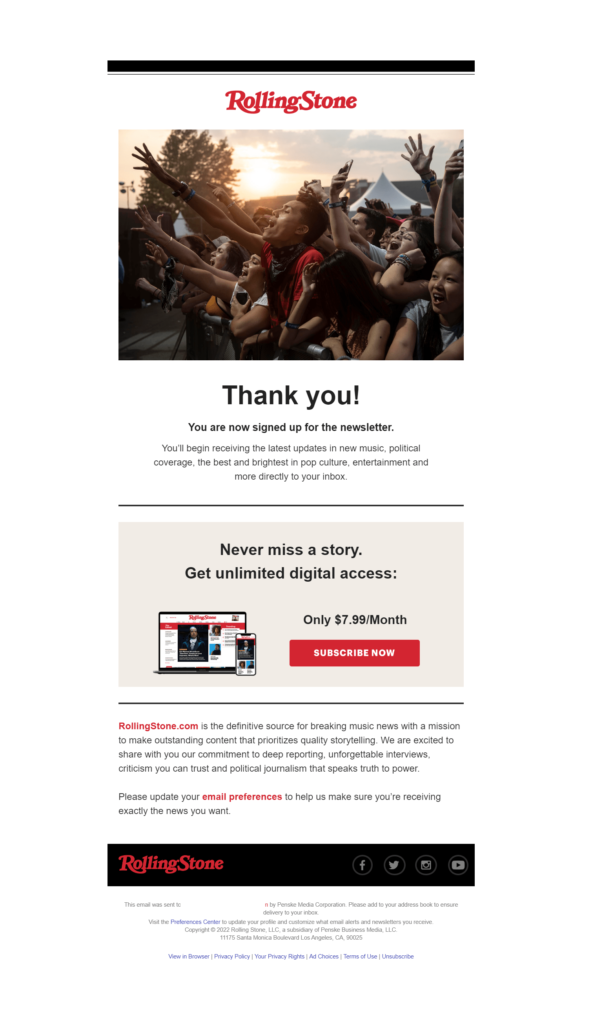
✨7 benefits of effective customer onboarding✨
- Increases conversion rates by helping prospects realize the value of your product or service and averting abandonment during the adoption phase.
- Decreases customer churn rates by ensuring that purchasers achieve their goals.
- Improves customer satisfaction rates by making it easier for users to maximize the value they obtain from your product or service.
- Delivers positive customer experiences through proactive measures that prevent user errors and friction.
- Enhances brand reputation by demonstrating that you are committed to customer service after the sale.
- Enables you to orchestrate and optimize your customer’s post-activation journey toward mutually beneficial outcomes.
- Builds long-term customer relationships, increasing customer lifetime value, lowering customer acquisition costs, and activating brand advocates.
When should you send onboarding emails?
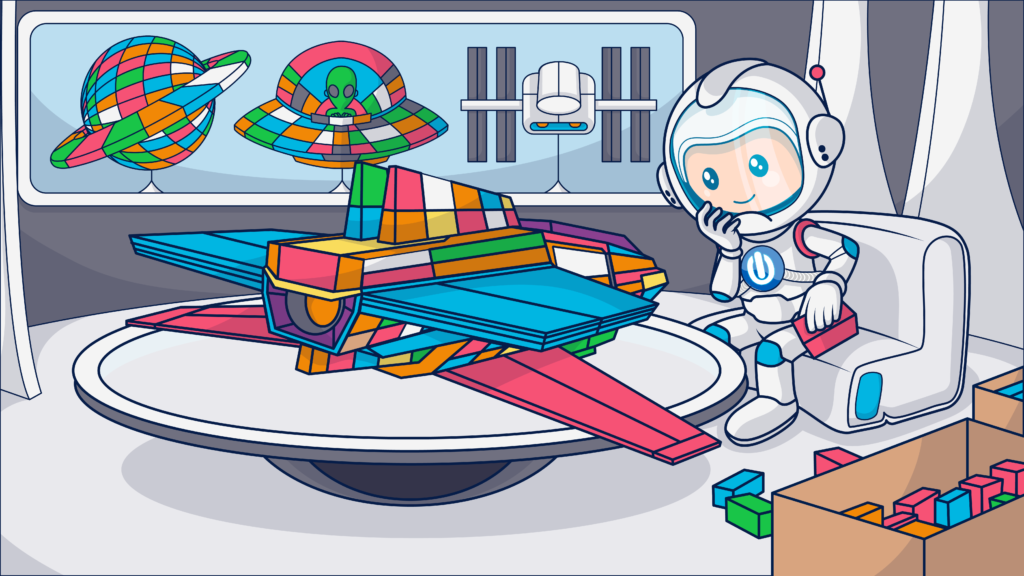
Onboarding through email communications or other channels such as in-app tips, video tutorials, or live customer support engagements may take place anytime a person’s interaction with a business represents a conversion event.
Once that conversion action happens, onboarding’s role is to ensure that it sticks.
Common conversion actions that trigger onboarding include:
- Product or service purchases or free trials.
- Paid or non-paid subscriptions.
- Account registrations or sign-ups.
Onboarding in different forms may continue through the expansion and advocacy stages as part of a full-cycle relationship-building marketing strategy. For example, a loyal customer who becomes a referrer for the first time might receive onboarding instructions related to their new journey as a brand advocate.
Depending on the complexity of your product or service and the diversity of your audience, you may need several onboarding flows and sequences to achieve all these goals. Different users and contexts require different responses.
To determine where onboarding emails can be most effective in ensuring new user or customer stickiness, map your customers’ journeys.
The data management tools we shared in our Email Marketing Tools To Drive Your 2022 can help you define and visualize your customers’ journeys.
For each audience segment, identify the pivotal touchpoints in the buyer’s journey that transition someone from one level of interest in your product or service to the next.
These are the moments where an onboarding email can be the lever that triggers someone to take action.
When examining your customer journeys, pay particular attention to when post-conversion drop-offs occur. These are moments when you’ve lost momentum or connection with your customer.
- Did they try to buy but didn’t?
- Is there an identifiable interval after which people stop purchasing your products or using your service?
- Can you pinpoint any sudden drop-offs in the frequency of engagement or purchase?
Support recovery of these lapsed customers through:
- Re-engagement and reactivation email messages.
- Cart abandonment email sequences.
- Browse abandonment email workflows.
Is becoming an email subscriber a conversion event that requires onboarding?
Traditional onboarding is thought of as a process for trial users or purchasers.
However, email list subscribers need onboarding, too! Those email list welcome flows you send to new subscribers are one type of onboarding email.
When a new subscriber provides you with their contact information, they expect something to happen.
Some businesses onboard new subscribers with a welcome email introducing their brand. Other businesses acquire new subscribers by making an offer and their onboarding email sequence is the follow-through on that offer.
Sellers of physical products often use their email newsletters and other campaigns to engage in attraction marketing and to familiarize people with their brand, its values and products or services. Digital publications may send users a basic version of their email newsletter as a method to generate paid subscriptions.
If all goes well, your welcome email will be the first of several onboardings you’ll share with your subscribers as you convert them into customers and brand advocates.
Why email onboarding is such a valuable tool for achieving customer (and business) success
Most onboarding programs employ a multi-channel approach to deliver the right onboarding messages at the right time to each person.
For digital products, including mobile or desktop apps and online services such as job boards, much of the onboarding activity will occur within the app or through the provider’s website.
Physical products, like Legos, may deliver printed instructions as well as use digital channels as part of their onboarding system.
Among the many channels through which you can reach your customers and support their journey, however, email is key.
Email’s ubiquity as a means of communication makes it ideal as an onboarding tool.
In fact, people expect to receive a welcome email when signing up to try or buy a new product or service.
If you don’t follow through, your prospects may doubt your company’s reliability.
Plus, onboarding emails are uniquely positioned to boost the effectiveness of your onboarding program because of their flexibility, accessibility, and capacity for personalization at scale.
Because email marketing is built for segmentation, it can easily accommodate different onboarding flows for different customer segments. Additionally, using branching logic, your onboarding emails can adjust to each onboarder’s behavior.
Not all Lego enthusiasts are ready to take on the 9,000+ piece Colosseum. Recognizing this, the brand guides users to select the right building set for their age and skill level. By pointing people toward the product and content best suited for them, Lego safeguards user experiences.
Similarly, it doesn’t make sense to send the same onboarding message to someone who signed up for a free trial but never activated it and someone who has explored the product extensively during their trial period.
Power users of related tools or apps may even appreciate the option to skip all or part of your onboarding series.
The best onboarding processes are customized to meet the needs of people at different stages in their buyer’s journey and with different attributes.
Behavior-triggered emails reach people when the time is right, reminding them when they are ready to take the next step in their onboarding or that they are running out of time to get started.
The risk of drop-offs during the adoption phase is another important reason that emails should be a part of your onboarding process. You can’t deliver in-app tooltips to someone unless they open your app!
Email onboarding reduces customer churn by taking your messages to the customer, instead of waiting for (and hoping) that they’ll come back to you.
Sending onboarding emails to people who have purchased physical products allows you to have input into their experience and communicates your continued interest in their success.
Have you ever purchased an item and after trying it decided that it wasn’t all that you’d hoped for?
Maybe the product was a dud. But it’s also possible that you weren’t able to get the full benefit of your purchase because you didn’t understand how to activate all its features.
Prior to 2015, Apple MacBook chargers had pop-out hooks that could be used to wrap the chargers cord around for storage. Many people never knew, writes Georgia Coggan in a 2022 article at the CreativeBloq.
I’m not saying the cord storage was a make-or-break feature. But still, if you don’t tell customers what’s great about your product, who will?
Finally, email is a relational channel that invites two-way interactions.
Personable messages that express appreciation, offer assistance, advice, and encouragement humanize your brand and nurture brand loyalty. This medium of communication facilitates the kind of connectivity that today’s consumers expect.
How can you enhance your subscriber and customer experiences with email onboarding flows? Leverage email’s flexibility to send right-timed messages that add value and maintain momentum at every stage.
How to use onboarding emails to drip feed messages and onboard new subscribers and customers
Every product or service onboarding flow begins with a consumer action. Someone has signed up to try your app, use your services or receive your newsletter, or they’ve made a purchase of a product or service.
Once your onboarding process is set into motion by this action, you may decide to send an event-based onboarding drip campaign that contains the same content and arrives on a predetermined schedule or develop behavior-based email flows that are sent in response to the individual recipient’s behaviors.
Your ideal onboarding flow will probably include a combination of both event- and behavior-triggered messages sent automatically.
Which type of drip campaign is best for onboarding?
Responsive, behavior-based campaigns are a powerful tool to ensure that your messages arrive at just the right moment. For example, you could develop an email flow that includes offers of assistance and tooltips that are sent when a new user’s in-app activities indicate they’ve encountered a problem.
You can create an entire set of autoresponders keyed to each stage in your in-app onboarding process or aligned with your service’s or product’s normal adoption path. If your customers usually resupply with your product monthly, your onboarding series could include a sequence that reaches out to people who don’t place an order within 35 days of their first purchase.
Precise timing plus using dynamic content fields or blocks in your onboarding email templates enable you to create one-to-one messages at scale and speak to each customer about their exact, in-the-moment needs. For instance, your nudge messages might include an image of their favorite purchases or a table showing their in-app activity level.
On the other hand, sometimes it makes sense to use a single, set-it-and-forget-it automated email workflow to facilitate onboarding.
What? Am I really advocating a less personalized approach?
Stay with me on this…
Capturing attention and demonstrating value quickly is a core function of onboarding, so the timing of your onboarding messages is critical. ⏱
Onboarding emails are most effective when they are delivered during that fleeting window of opportunity that exists when someone has signaled interest in a product or service and before that interest is lost.
Plus, for limited-time trials, delaying your onboarding messages until your customer takes action may mean they don’t arrive before the time is up.
📧The onboarding drip campaign from language learning app Gymglish is an example of a scheduled sequence that uses branching logic to customize the messages each trial user receives.

Gymglish offers new app enrollees a 7-day free trial. Once someone signs up, they immediately receive a welcome email that explains what to expect and includes links to additional resources and to the first lesson in the series.
If the subscriber doesn’t begin their trial lessons, they receive a follow–up nurture email reminding them to get started.
This message has fewer links to resources, placing the focus on a button-style CTA that takes the subscriber to the first lesson. Subsequent emails also prominently feature a “Start Your Lesson” CTA because completing this first lesson is an essential task if users are to experience that all-important aha moment.
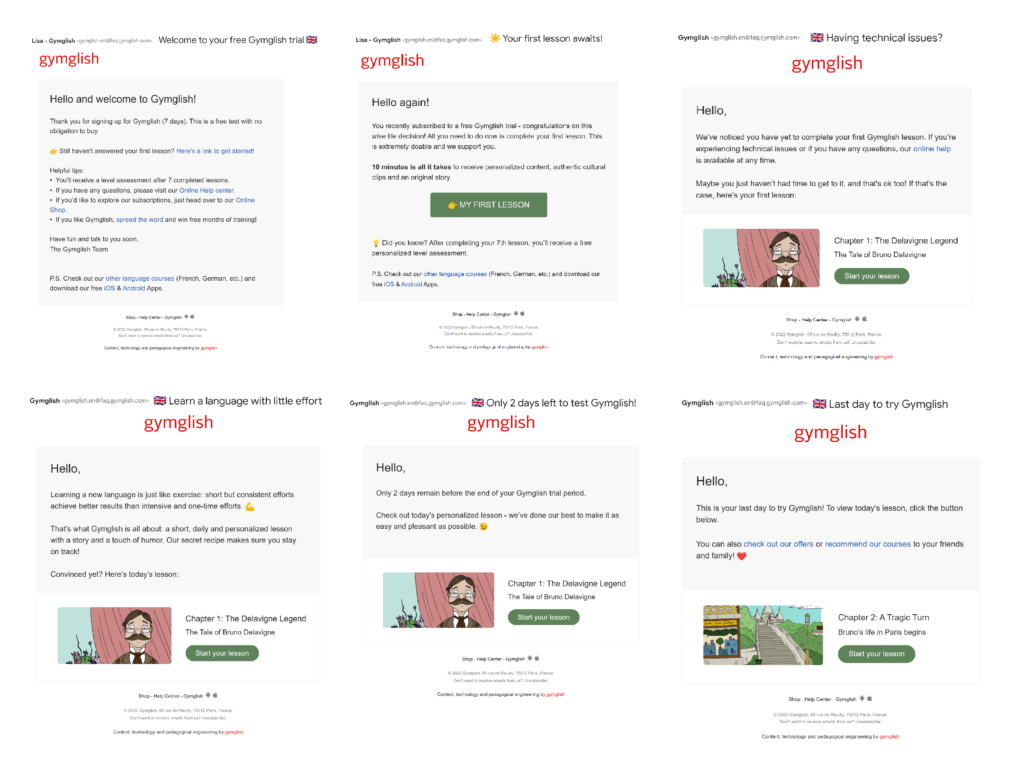
Messages on day 6 and 7 after sign-up count down the remaining days left for the user’s trial. Once the trial period has ended, the subscriber receives a 7th message offering them 20% off a subscription to the app (not pictured).
In the example I’ve shared, the subscriber waited until the final day to revisit the app and try the first lesson.
Because there are only 7 days for trial users to experience the app, Gymglish’s drip campaign follows a predetermined cadence.
However, I’m assuming that subscribers who engaged with the app during their trial period get mid-campaign messages relevant to their activity instead of our example subscriber’s “get started” nudges.
Setting up new app users for success is just one way onboarding emails can keep customers engaged. There are a lot more!
26 types of onboarding emails to keep the conversation going with your new customers and subscribers
Like in-app or on-site messages, emails can be used to introduce new users to your brand or a product or service.
Use them to nudge consumers into taking the next best step on their onboarding journey, offer assistance and information about your product or service, and encourage users to continue their progress, explore new features and benefits, or make a purchase or upgrade.
Introductory and education onboarding emails
- First welcome and thank you
- Welcome drip campaign to greet, set expectations and provide navigation links
- Housekeeping and account information messages
- While you wait messages for products that require set or shipping
- Links to product walkthroughs and task completion videos
- Instructions for taking the first step or completing first task
- How-to guides for individual or multiple steps
- Frequently asked questions (with answers)
- Primary “Aha” feature focus message
Onboarding continuation nudges
- Complete sign-up or registration
- Invite your team
- Take the first step
- Take the next best step
- Explore more features
- Complete free trial
- Purchase or upgrade
Ongoing engagement and success messages
- Secondary added-value introductions and guides
- New feature announcements
- Tool tips and shortcuts
- Congratulations and encouragements
- Progress and use reports
- Statistics and expert advice that affirm benefits
- Social proof such as consumer testimonials and reviews
Onboarding recovery messages
- Offers of assistance
- Requests for feedback
- Come back or retry offers
Examples of onboarding emails that guide customers along their buyer’s journey and toward great experiences
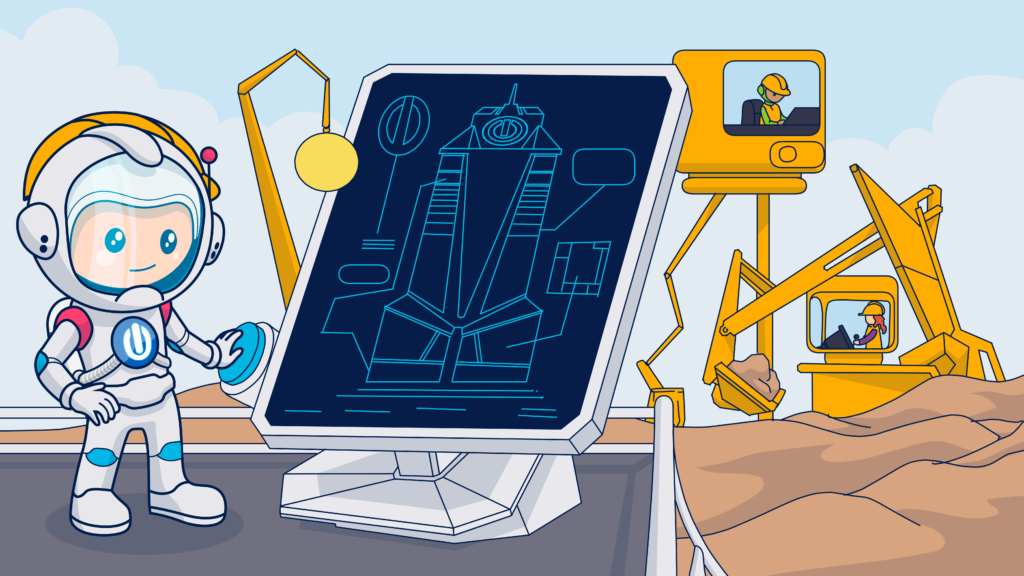
Onboarding emails may be simple one-liners or lengthy instructional guides.
Often, brands will combine more than one type of message in a single email. A welcome email may double as a reminder to invite team members or a tool tip message may include an invitation to upgrade.
Because building familiarity and liking contributes to the stickiness of a brand’s product or services, establishing your brand’s personality in these early messages is essential.
As you review these examples, look for inspiration you can use to create customized onboarding campaigns and content to fill gaps in your onboarding flow and meet your audience’s expectations.
Stage #1: Onboarding welcome emails
Say hello and confirm that your’e dedicated to your new contact’s success.
📩 Otter.ia engages busy customers with a short greeting and action-focused CTAs.
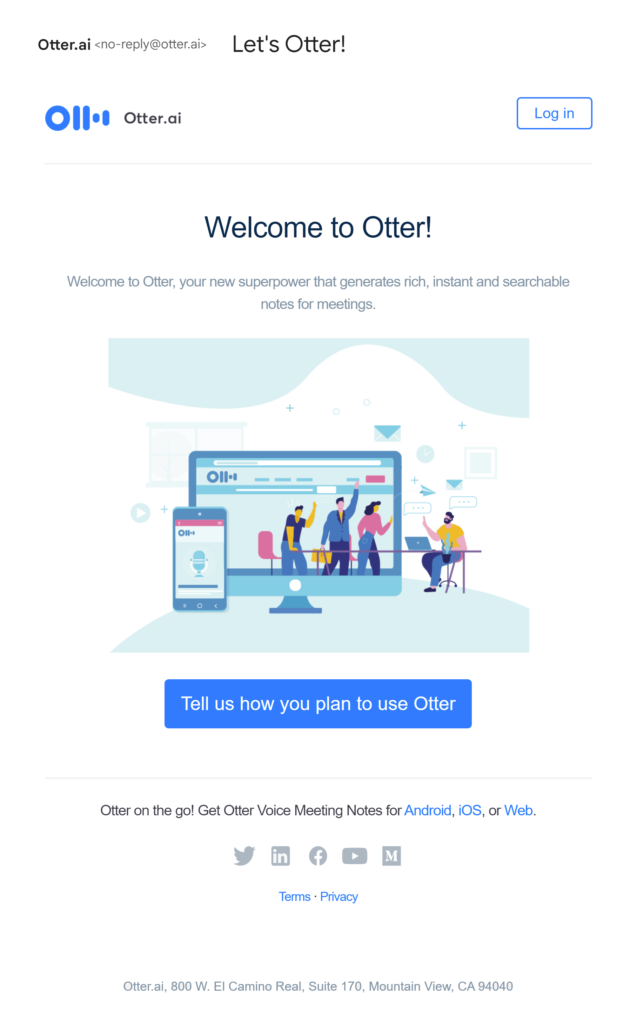
Transcription app Otter.ai’s welcome email includes a simple statement of its value proposition and a brightly colored CTA that asks new users to “Tell us how you plan to use Otter.”
Otter.ai’s inviting CTA increases the brand’s chances of earning engagement that will improve the deliverability of its future emails to subscribers who click-through and sets a customer-first tone. For subscribers who are ready to get to work, there’s a secondary “Log In” CTA at the top of the email.
📩 Adventure Academy starts the onboarding process with a value-adding order confirmation message.
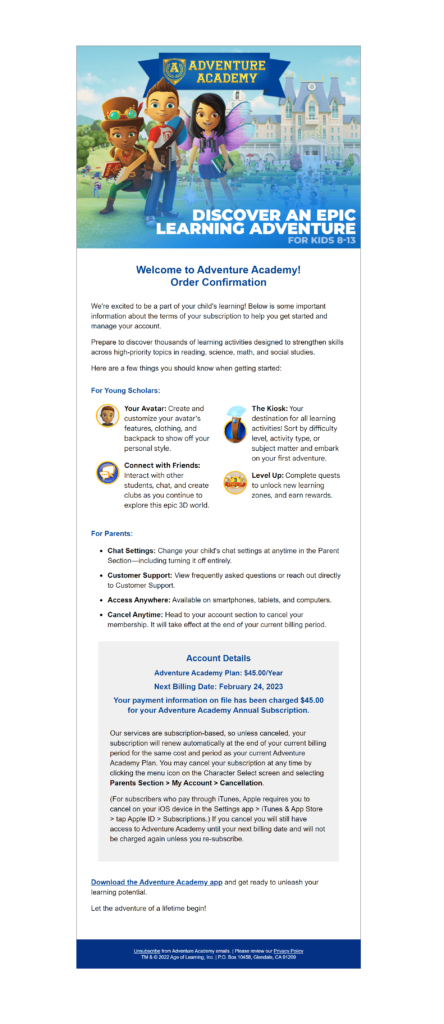
Academy Adventure is an online learning platform for kids so the brand has to appeal to both purchasers and users.
Its subscription confirmation message details how kids can get started playing on the platform and how parents can get the most out of their subscription. (The message also conveys important details about their transaction.)
📩 Baremetrics sets expectations and offers users alternative communication channels.
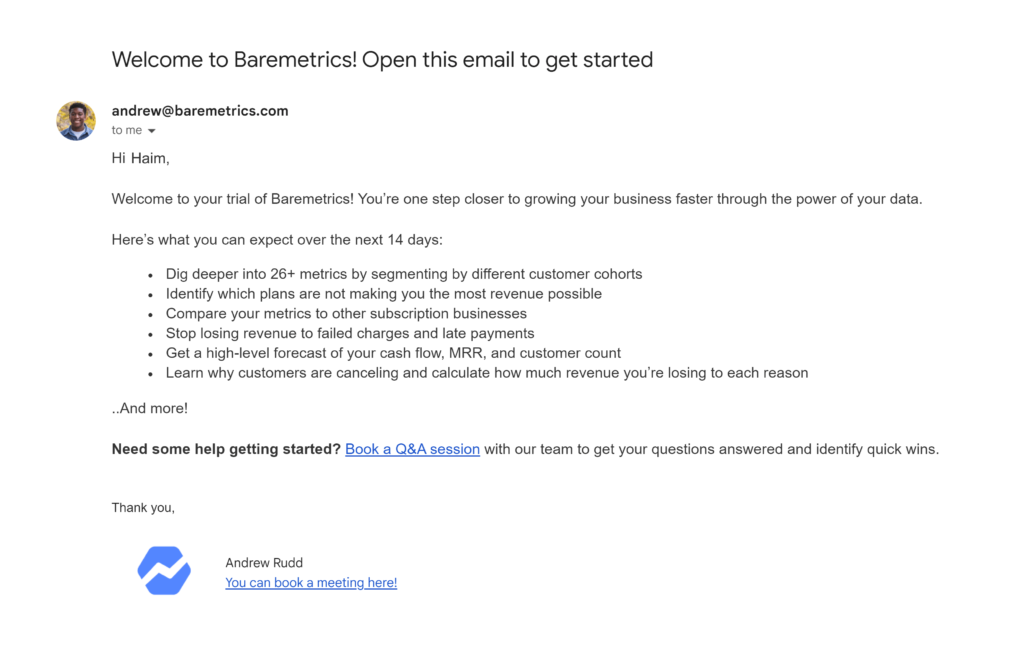
Targeting business users, Baremetrics’ welcome message keeps the HTML to a minimum with a mostly text format (not sure why? Check out our HTML vs. text article).
The CTAs for this onboarding email aims to accelerate the process by encouraging recipients to sign up for a live Q&A session or demo meeting.
Putting the user in control of how they receive onboarding communications sets you both up for success. Tell email recipients about your preference center and include a link in your onboarding email footers.
📩 Boot seller Ariat delivers on its promises and personalizes its brand with a welcoming message pair.
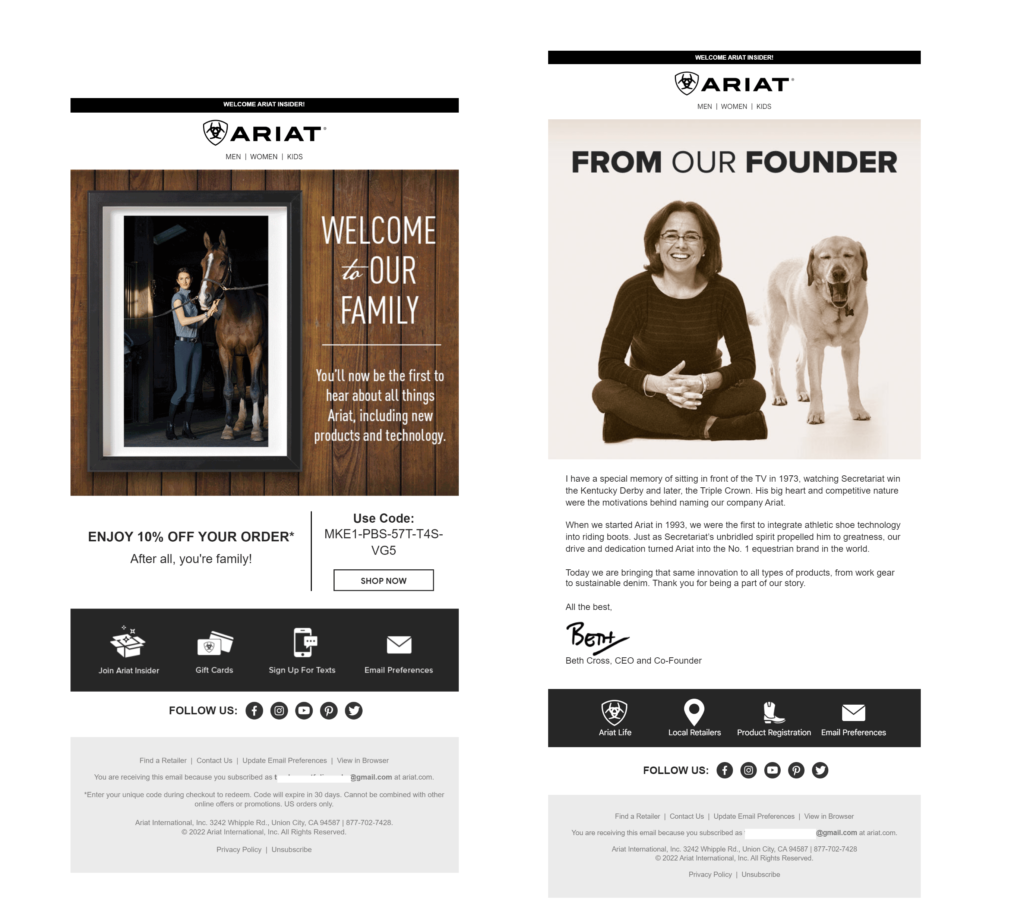
Footwear brand Ariat welcomes new email subscribers with a warm, casual greeting that delivers the discount promised during sign-up. The brand follows up on this first contact with a message from the brand’s founder. (The pictures of pets with their humans adds an extra layer of personality.)
📩 Chameleon shows its style, and anticipates and overcome objections in a feature-focused introduction.
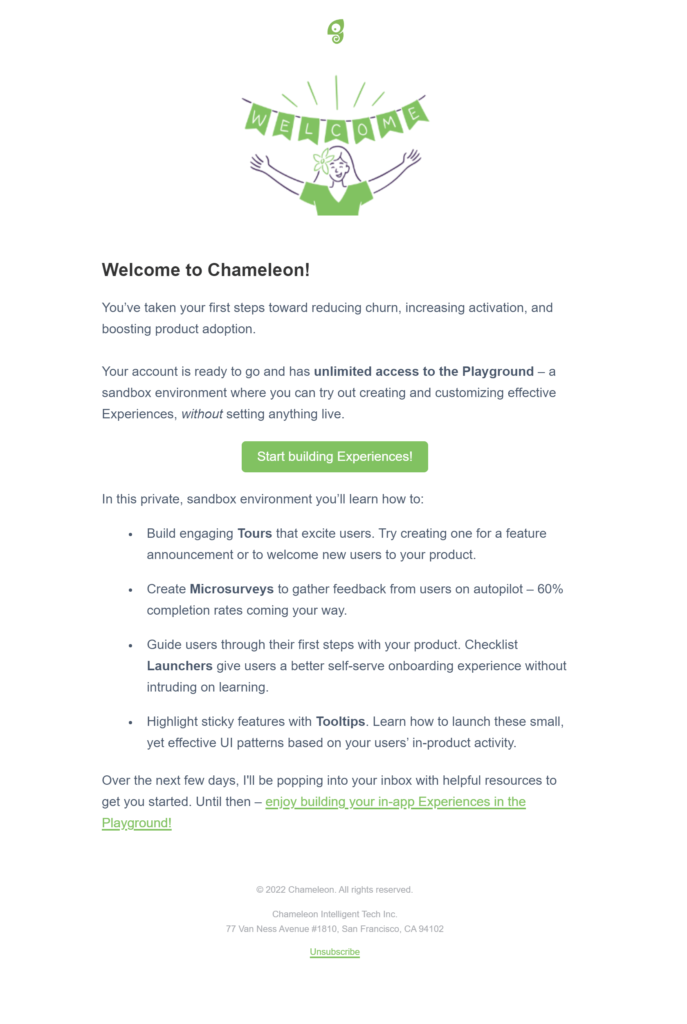
Product adoption support app Chameleon welcomes new trial users with an encouraging invitation to test the product’s capabilities in a no-risk playground environment.
This personable message summarizes the platform’s key features (and their benefits) and tells users what to expect next with a friendly, “Over the next few days, I’ll be popping into your inbox with helpful resources to get you started.”
Chameleon’s follow up nudge message invites users to imagine what they can achieve and describes how the platform can help them achieve it. “What’s your first goal…?”
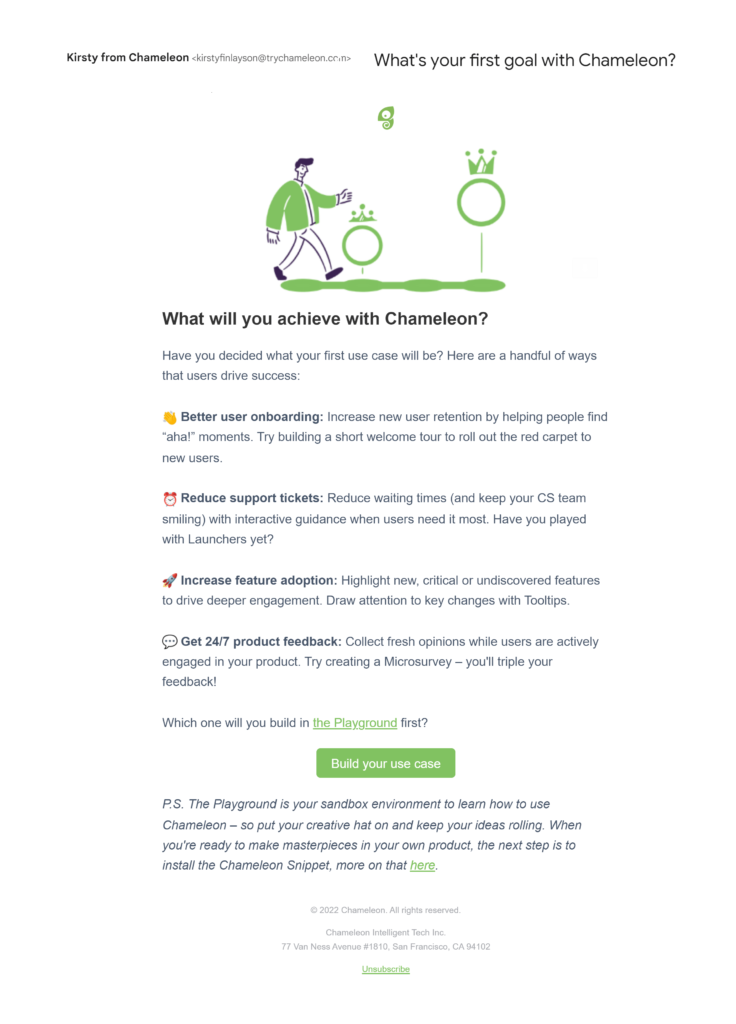
📩 BeeFree Pro takes new users from zero to success with a sequential six-pack.

Email template tool BeeFree doesn’t wait for people to return to the brand’s website to teach them how to get the most value from their Pro account trial. After sign-up, users receive a numbered series of messages that walk them through the essential steps from A to Aha!
BeeFree’s onboarding series includes a mix of information and formats.
BeeFree Pro’s welcome email includes a link to a video walk through and tells users what to expect next. Message number 2 offers step-by-step instructions with accompanying graphics, while message 3 opens up with an animated tool tip GIF.
Closing out this fast-track to success series is a recap and an offer of assistance.
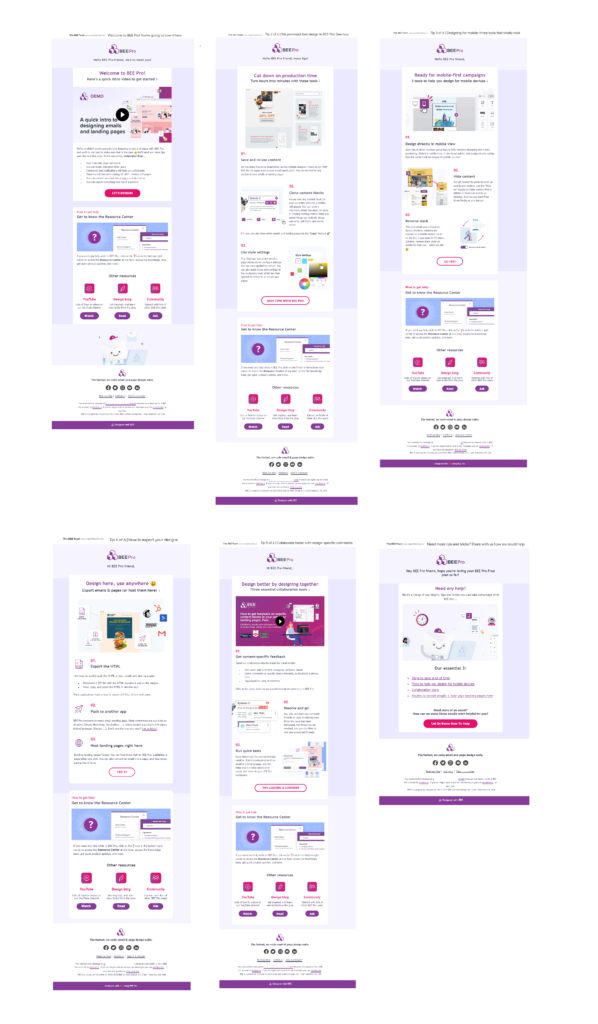
BeeFree Pro is free for life for single users and teams. Teams that want premium collaboration tools need to upgrade.
By bringing new subscribers up to speed quickly, the brand increases the chances of team adoption—and team upgrades.
📩 A business product provider speaks to dual audiences in a two-piece welcome and education flow.
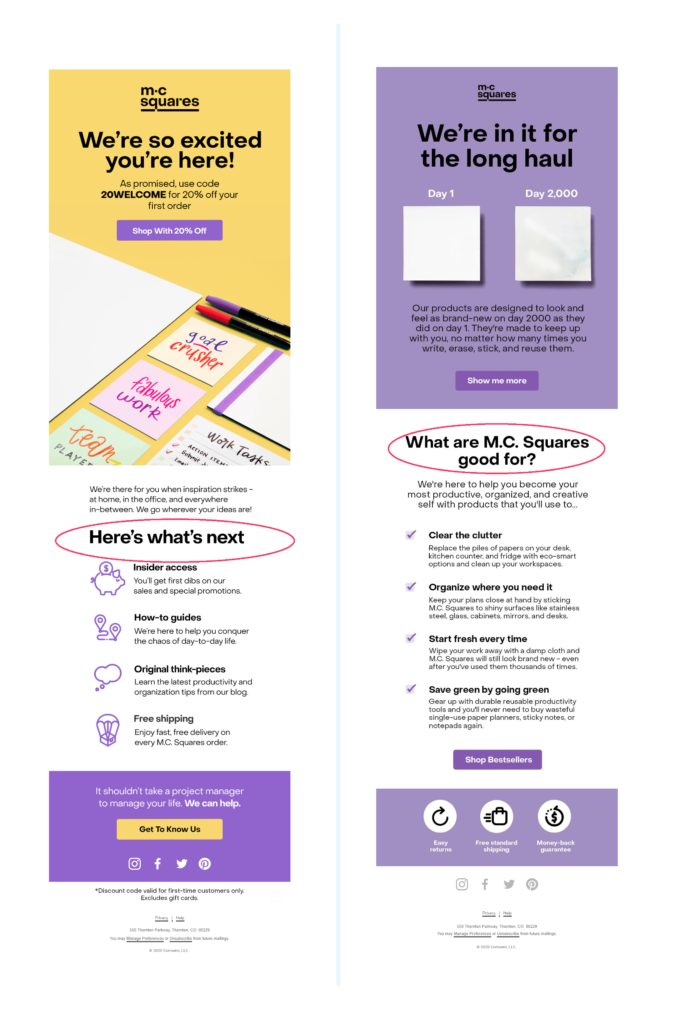
M.C. Squares sells reusable whiteboard accessories to both businesses and consumers.
But, the brand doesn’t always know which type of customer it’s dealing with when they first subscribe. So the brand’s onboarding message is designed to appeal to both. In its two-piece series, M.C. Squares first greets new subscribers then follow-up with its value proposition.
M.C. Squares also uses these messages to tell subscribers what to expect from the brand’s email newsletter and invite them to follow the company on social media and direct them to the company’s blog with a “Show me more,” CTA.
Email newsletters can serve as a channel for onboarding your subscribers and customers, too. Create a segment for new subscribers, app users or purchasers of a specific product and send them a newsletter that supports their success.
📩 Outside Online leverages content and community to strengthen introductory-stage stickiness.
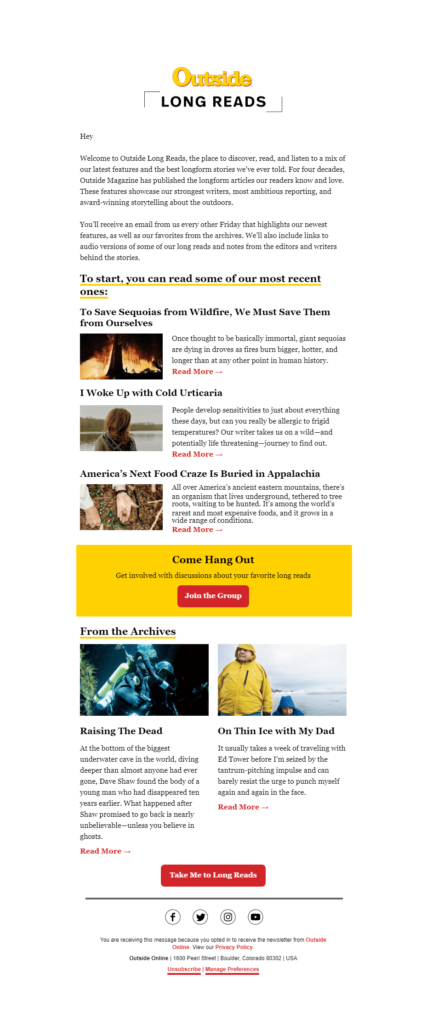
What’s a print or digital magazine’s aha moment?
Outside Online thinks linking new subscribers to the publication’s most popular articles will do the trick. As an added incentive to make reading the brand’s content a habit, the welcome email includes a link to Outside Online’s Facebook community.
📩 National Geographic enhances magazine subscribers’ experiences with instant digital access.
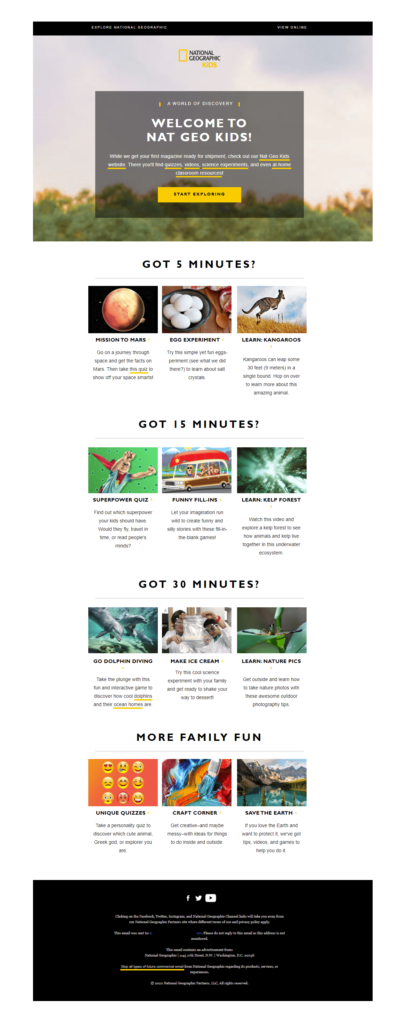
Subscribers to National Geographics Kids don’t have to wait for the first copy of the physical magazine to arrive to start enjoying their purchase. The publisher sends a welcome email packed with links to online games and other activities.
The email includes engaging graphics and a navigational assist for busy parents: The activity links are sorted by the time it takes to enjoy them. “Got 15 minutes?”
Stage #2: Onboarding nurture emails
Maintain the momentum and prevent drop-offs with campaigns meant to eliminate friction and encourage success.
📩 “Your free trial is waiting” reminders can recall people who forgot they were interested.
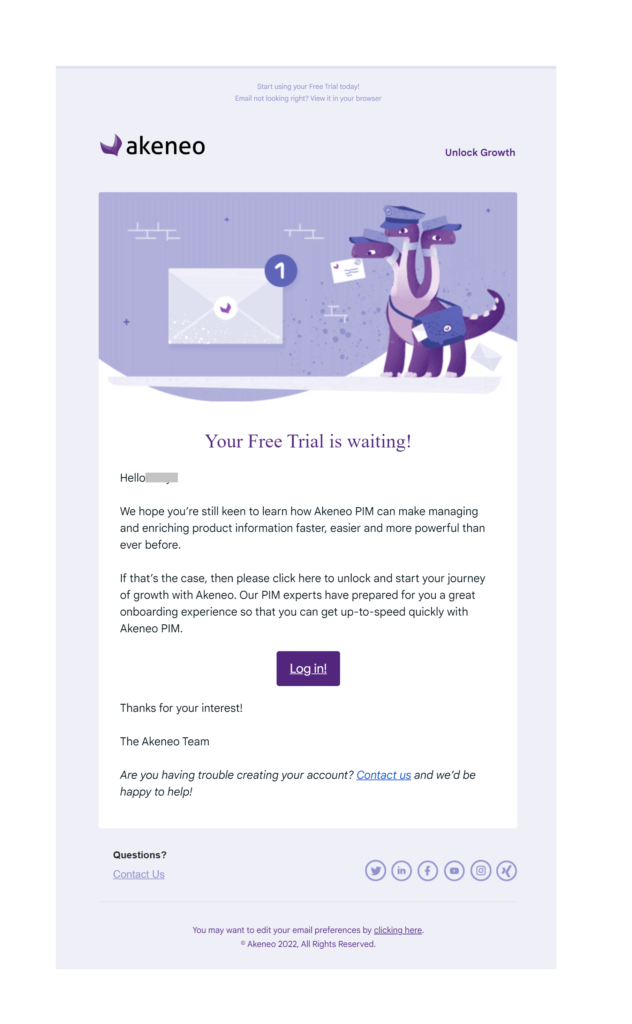
Sometimes we see an app, think we’d like it, sign up to try it and then… life happens. This simple, friendly message from Akeneo refreshes people’s memories and makes taking the next step easy with direct-to-the-point “Log in!” CTA.
Boost your click-through rates by making your email CTAs action-based and easy to spot and click.
📩 Productivity and team collaboration app Twist uses more than one tactic to engage new trial users.
Twist’s onboarding email sequence includes messages stating the product’s benefits, encouraging action and requesting feedback to get the onboarding ball rolling and keep it going.
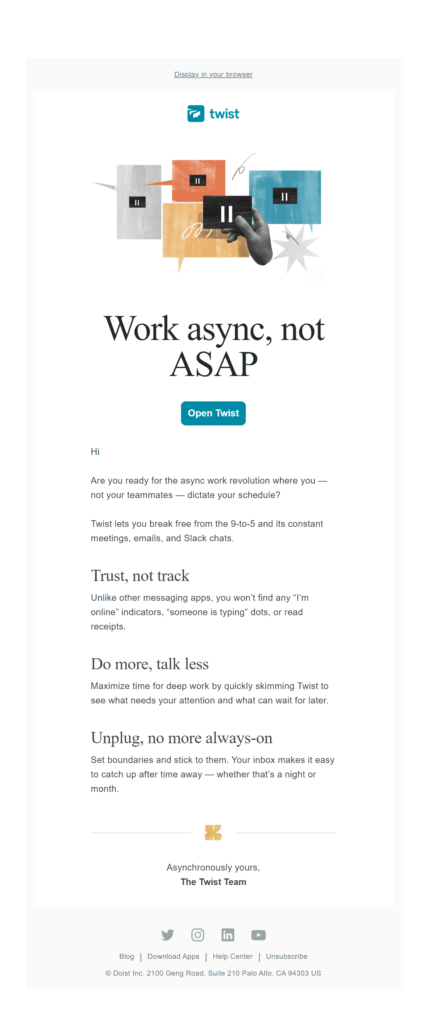
The brand uses a nudge message to get users to put the pieces in place so they can fully realize the value of its tool.
Getting someone to involve their team in trying out a collaborative app is a great way to spread awareness and speed adoption. Adding team members is a solid intent signal!

For many apps, the aha benefits are only truly revealed through productivity-enhancing collaborations. Twist puts teamwork at the forefront in its messaging to strengthen its onboarding impact.
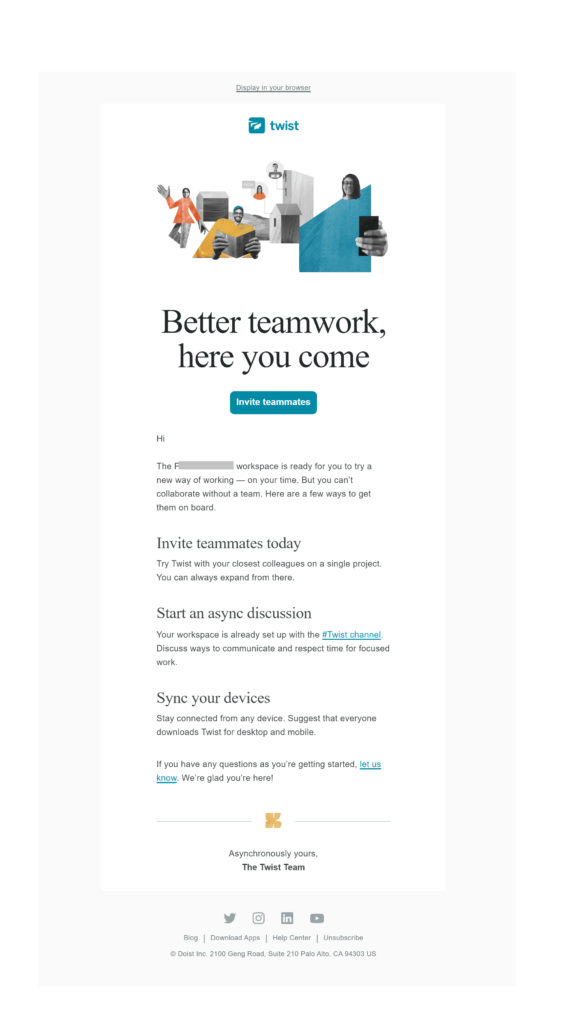
📩 Helping new trial users to overcome inertia with “just have a little taste” nudges.
Maybe it’s just me, but one reason I don’t always try an app even after I’ve signed up is that it requires me to set aside time to try the app.
Harvest, a time-tracking and invoicing app, gets this. Their welcome email sets a firm tone, explaining how if you use the app, you will benefit.
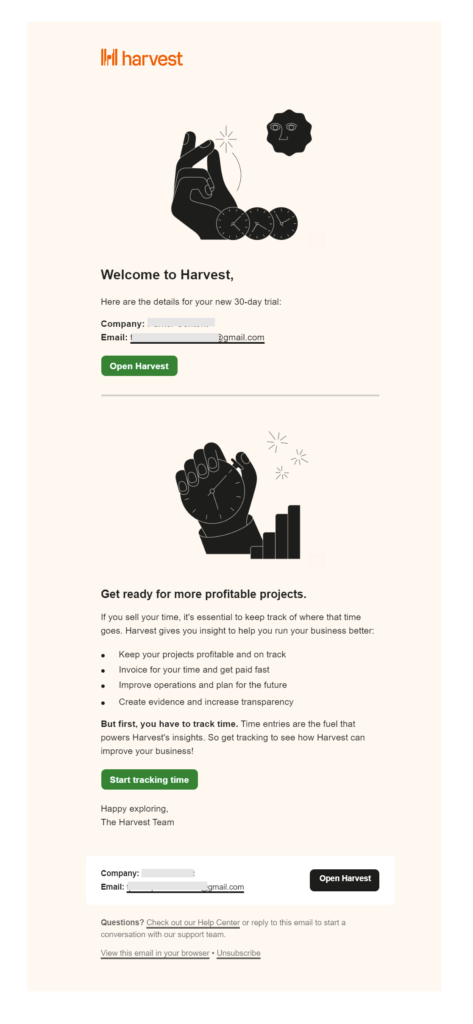
The brand’s follow-up message to users who haven’t engaged with the app asks them for just one minute to discover its value.
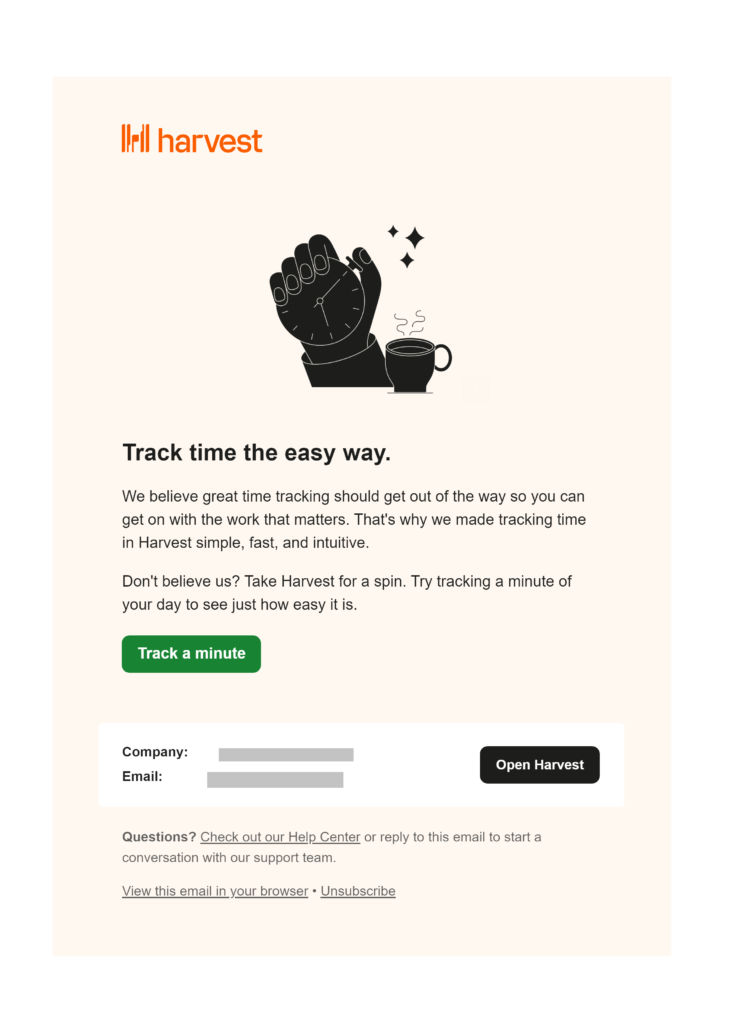
When someone signs up to try Harvest, they are asked to choose a date and time to receive timesheet reminders. This data then becomes the trigger event for an automated email that reminds the user to enter their timesheets each week.
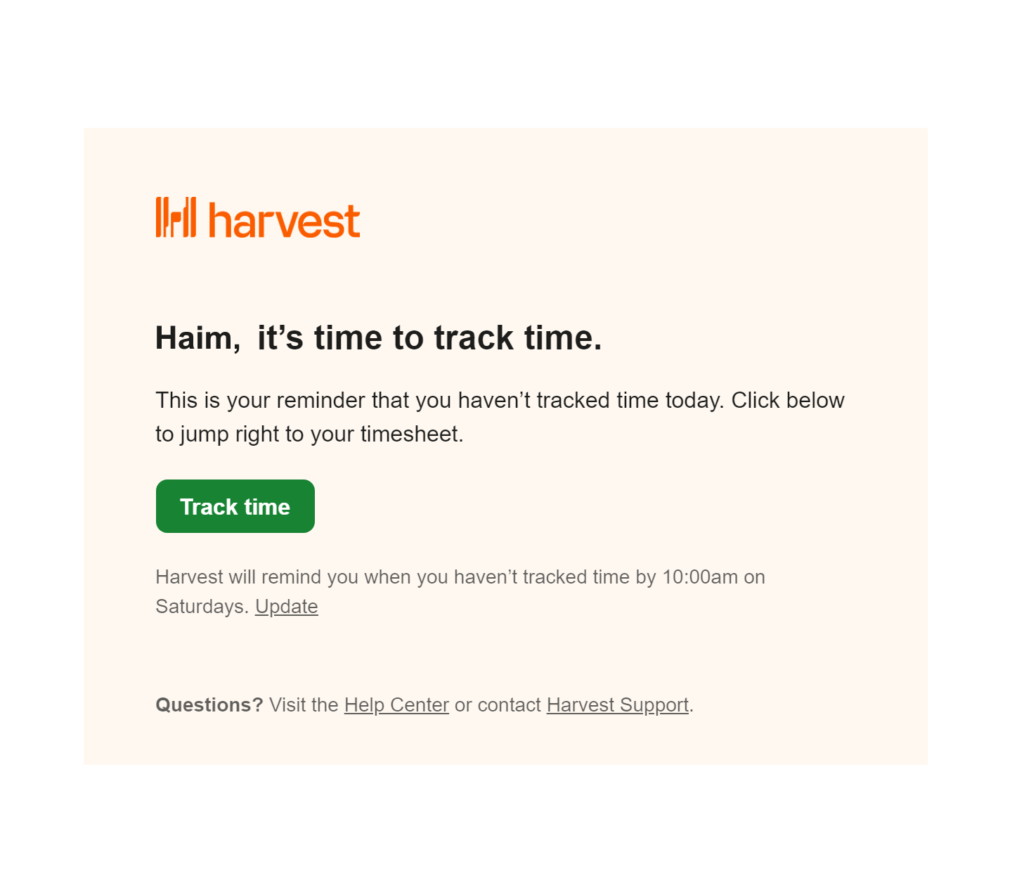
When copywriting your onboarding messages, think about your prospects’ perspectives. What can you say or do to break through their daily clutter?
📩 CRM platform Nimble gives new users a nudge with get started tips and an offer to assist.
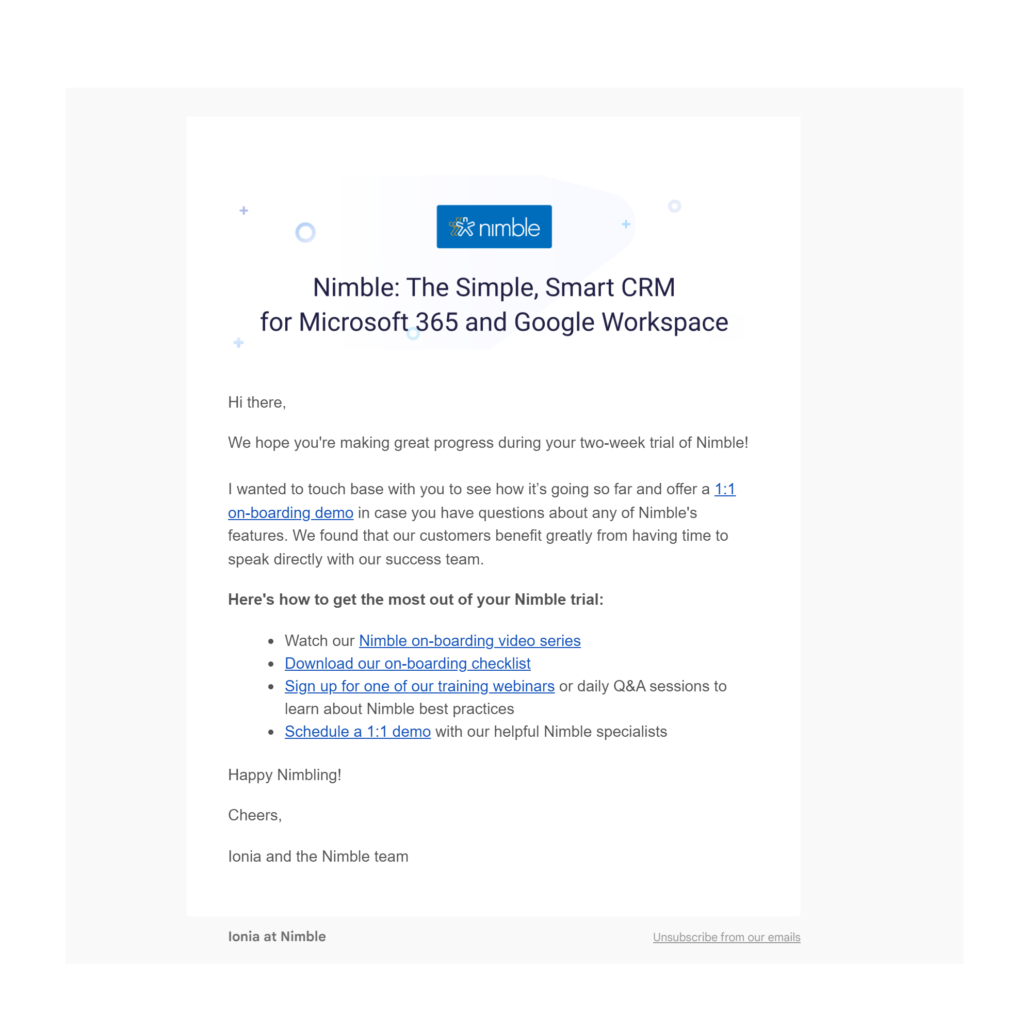
While not personalized, Nimble makes its appeal personal by sending it from a real person.
The brand also employs a something-for-everyone strategy by directing email recipients to several types of content, including videos, a checklist, webinars or a 1:1 demo, to help them learn more about the product.
Stage #3: Onboarding engagement and value-adding emails
Point out specific features and explain advanced options to customers who are ready to take the next step on their journey.
📩 Tooltip messages put your best features top of mind for new users.

Hiking navigation app AllTrails uses a freemium model, offering both free and Pro versions of its Navigator tool. This email encourages new free users to explore everything the app offers with links to popular tooltips.
Images that show both the tool and the adventures users can enjoy using it make me want to get out there and give the app a try!
15. ClickUp reminds customers to take advantage of its best features (because they can).
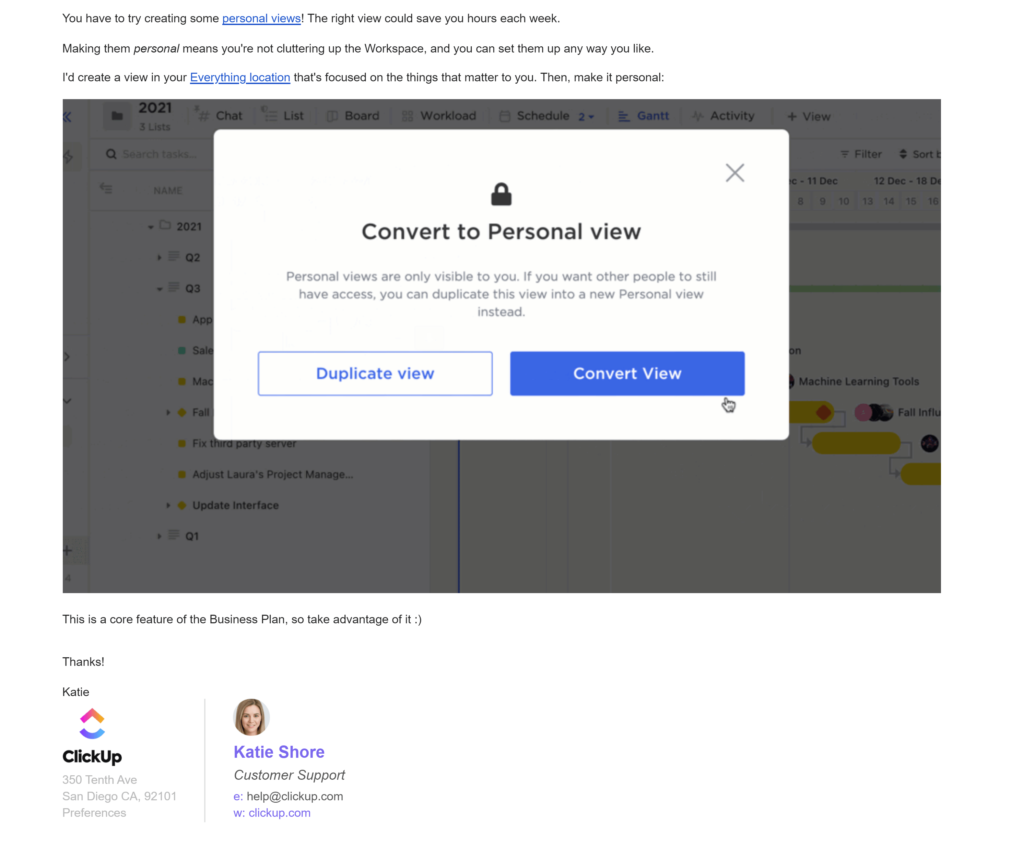
ClickUp premium account users gain access to customization features that aren’t available for freemium users. This feature-focused onboarding email sent to premium account team members hopes that once they discover the benefits of this feature, they’ll stick around.
📩 Bullet Journal goes for the upsell with a message highlighting its unique community.
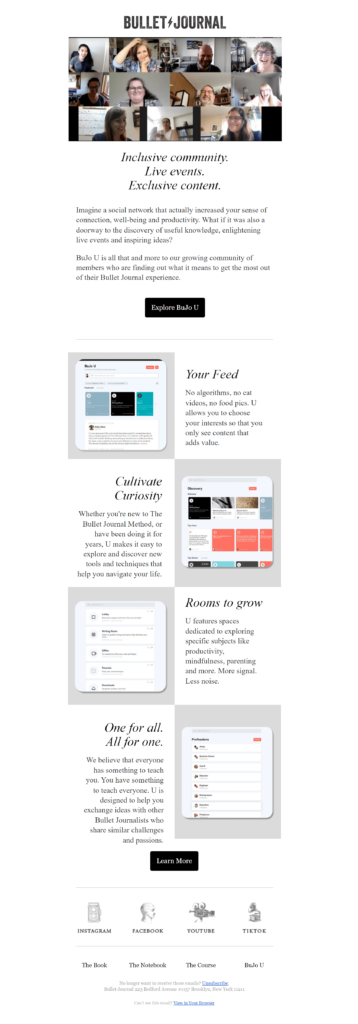
Bullet Journal’s nurture message appears shortly after its first few onboarding messages. The copy of this email emphasizes the many benefits of being a part of the brand’s exclusive membership community.
The header graphic use of an image capturing participants of a video discussion forum bolsters the message.
📩 ProWritingAid does the math for customers to demonstrate its product’s value.

ProWritingAid encourages subscribers to continue using the app with update messages that include elements of gamification, scoring their performance against previous weeks. The customized weekly updates also include advice and word art depicting the user’s activities.
Stage #4: Onboarding emails to recover lapsed customer and get feedback
After all the effort put into acquisition, don’t let your new customers go without making a recovery attempt. Use this stage to find out what your subscribers or users think about your product or service as well.
📩 Encharge keeps an eye on activity to know when it’s time to offer assistance.
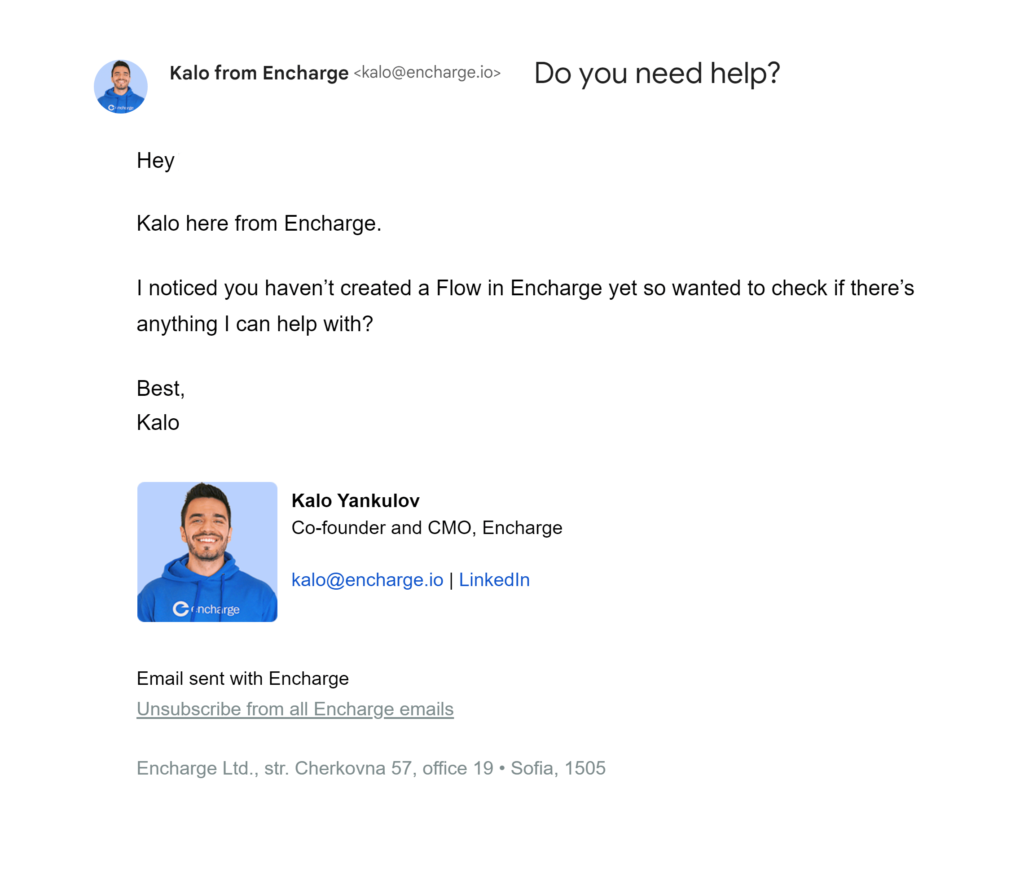
Trial users don’t always tell you when things aren’t going well or if they just aren’t interested in your offer. You can get ahead of a potential lapse in interest by sending inactivity triggered messages that offer to assist.
Your onboarding messages don’t have to be long to be effective. Encharge keeps this message from its co-founder friendly and short.
📩 “Hey, remember us?” feedback requests can bring back lapsed users or customers.
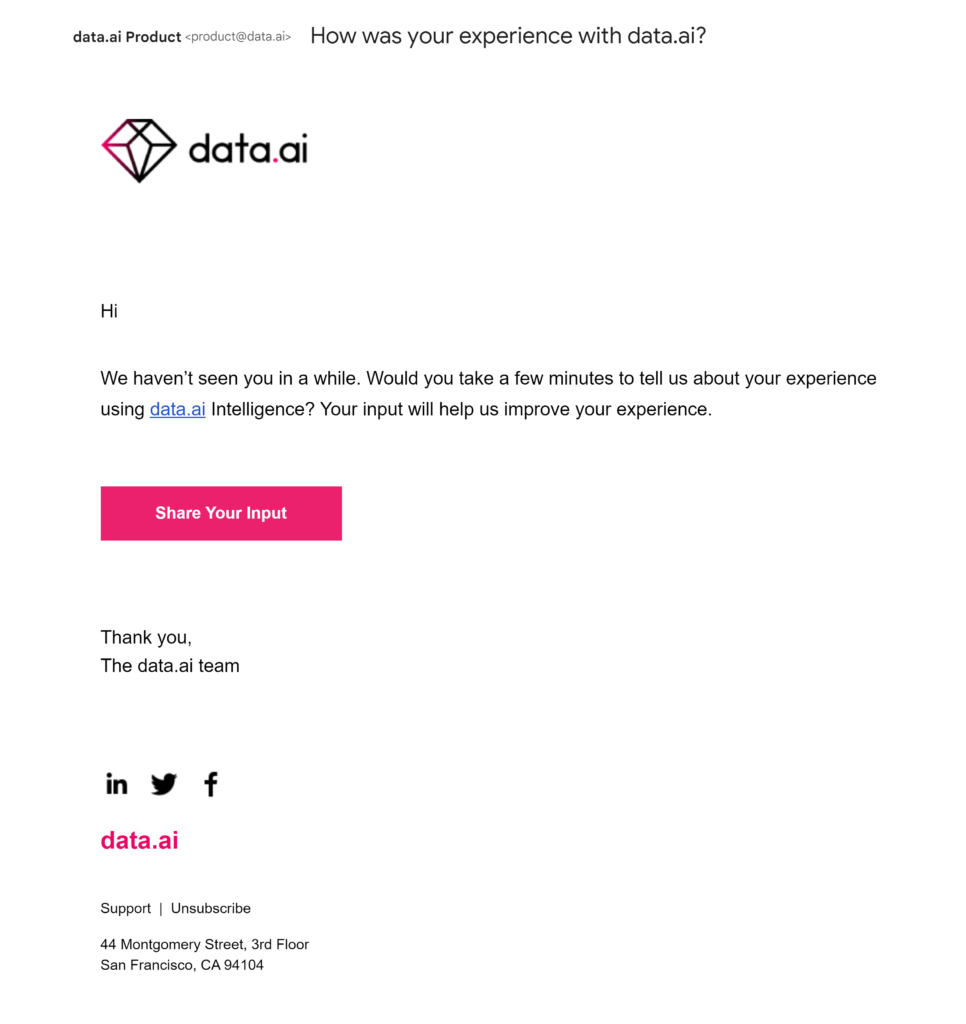
Data.ai offers plenty of assistance to users new to its somewhat complicated data analytics product.
But sometimes even the best help doesn’t overcome a trial user’s hesitation.
A feedback request communicates your interest in the recipient and may lay the groundwork for them to consider your brand in the future.
📩 Baremetrics tries reactivating trial users (or at least getting actionable insights) before throwing in the towel.
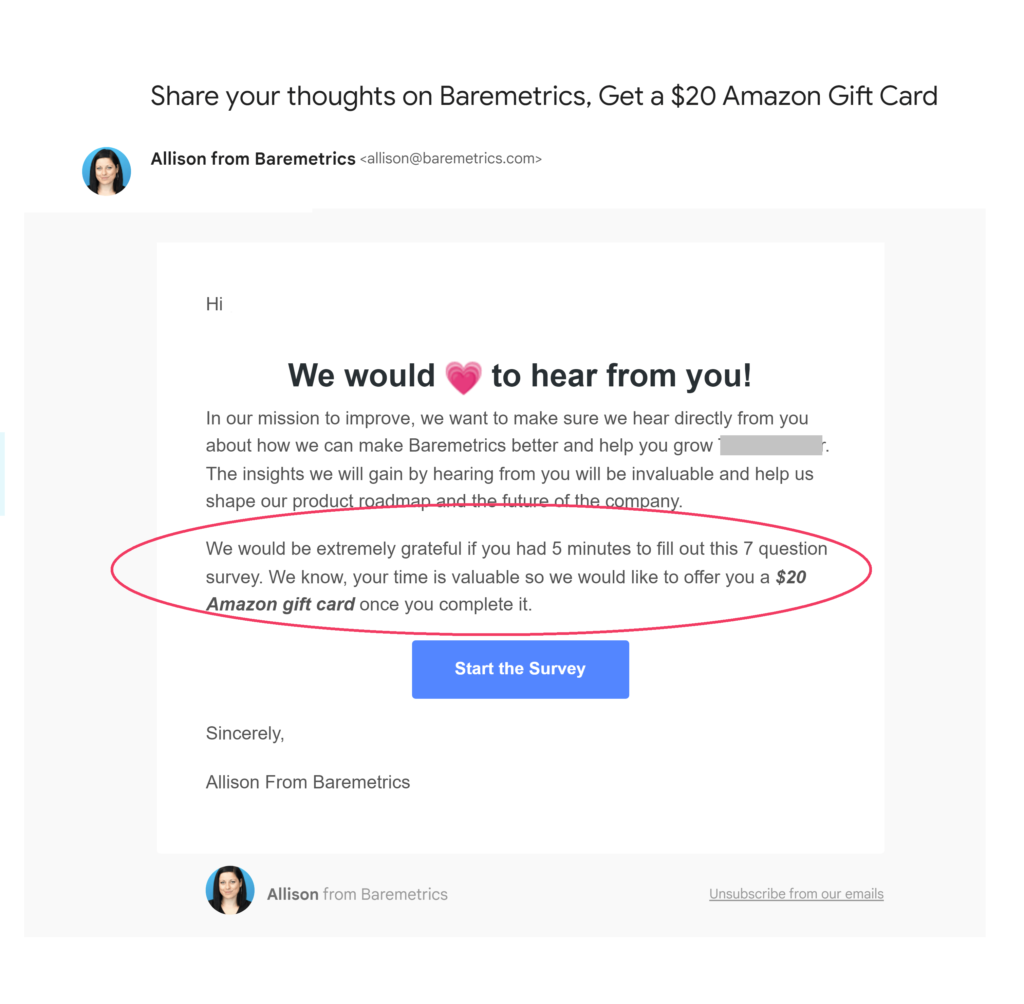
Baremetrics takes a personal approach and offers lapsed trial users an incentive to provide the brand with feedback. Expressing gratitude and disclosing how long the survey is likely to take increases the chance subscribers will respond.
Whether you choose a simple “Tell us what you think” message with a CTA or a more detailed approach, asking trial users what they think can help you focus your messaging and improve your product.
Don’t be afraid of negative feedback. Understanding what people don’t like about your product or onboarding process can unlock future opportunities.
📩 Reengaging with a retrial is an inexpensive way to take one more shot at conversion.
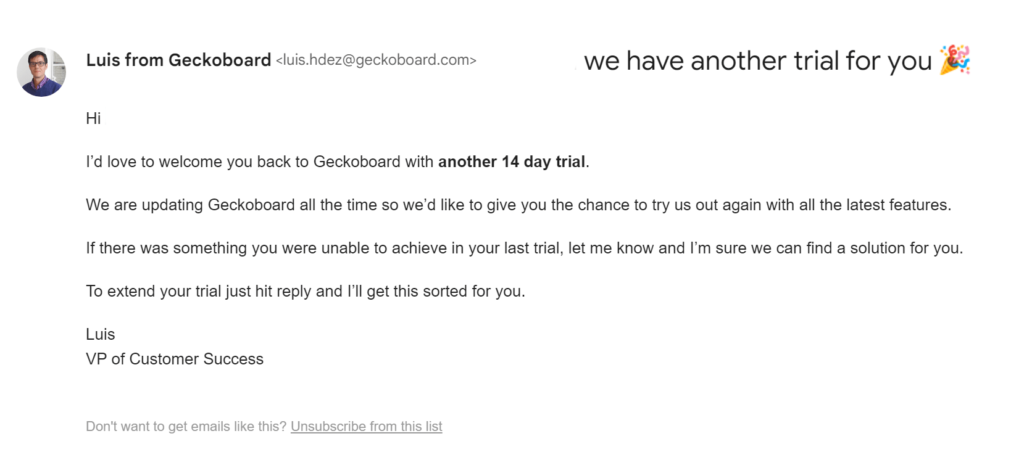
Geckoboard is a powerful analytics tool which people may have to take their time getting to know.
This personal free do-over message from the brand’s VP of customer success encourages people who ran out of time to give the platform another go. Recipients will appreciate the promise of personal service.
The takeaways: Onboarding email best practices and tactics you can use to activate and retain more customers
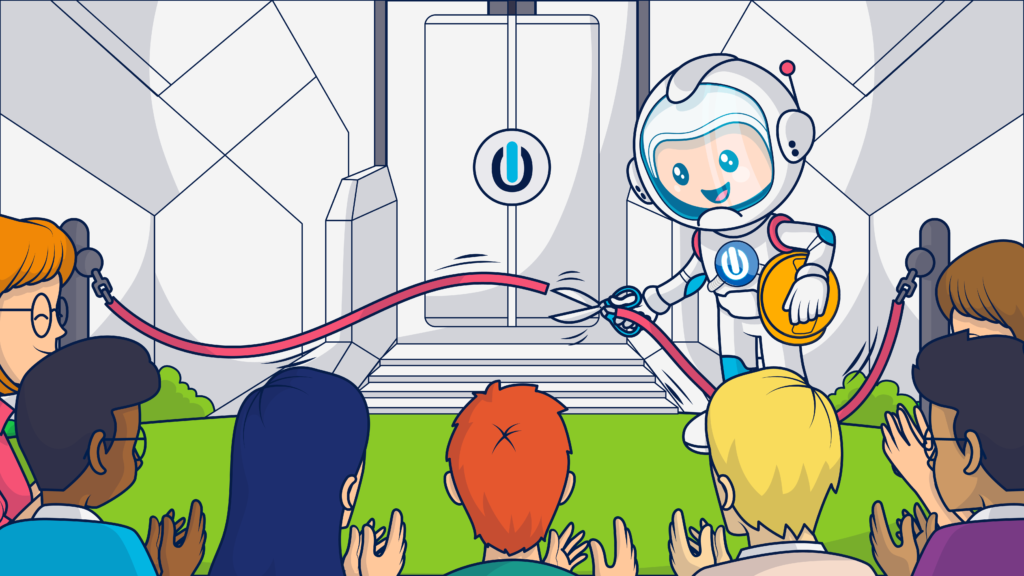
Your onboarding program’s primary objective is to help your users achieve the goals that made them want to try or buy your product or services in the first place. T
o do this, you’ll need to use what you know about your customers and about human behavior to reach them at the right time with the right message using email and your other onboarding communication channels.
Here’s a list of the best tips and tactics to help you accomplish your onboarding goals:
- Develop a coordinated onboarding framework that remains consistent across channels. Use personalization and cross-channel data integration to meet each person at their moment of need.
- Have a goal for each of your onboarding messages and monitor your KPIs.
- Approach your onboarding from a customer-first perspective that aims to reduce friction and speed uptake.
- Meet your customers’ learning and emotional needs with a balance of content and deliver formats.
- Don’t forget to build micro-success moments into your onboarding flows.
- A/B test all your onboarding processes, as well as your email onboarding series and individual email templates.
- Don’t give up too soon. If your first onboarding attempt fails, consider the risks versus the rewards of giving it another try.
As you prepare your onboarding email flows:
- Be aware of what happens after the click-through. Make sure users are directed to exactly where they need to be to complete the next onboarding step.
- Create separate email flows based on recipients’ place in their buyer’s journey and their behavioral or other attributes.
- Don’t overload onboarding recipients’ inboxes. Use a suppression list to exclude onboarding recipients from your email newsletter or promotional lists to increase the chances that when they open a message from your brand, it’s an onboarding message.
- Personalize your messages by using your recipients’ names and adding other customized details using dynamic content.
- Inform in-app or online subscribers or purchasers to be on the lookout for your onboarding emails so they don’t miss out.
- Make your subject lines unmissable. Every email marketer knows that before you get a click-through you have to get an open. Onboarding emails should make their purpose clear to avoid being mistaken for a less important message. Adding ordinal numbers to your onboarding series can help recipients make sure they’ve seen them all.
- Don’t use a no-reply sender address for your onboarding emails. Signaling a lack of real interaction on your part may trigger a lack of interest in your recipients.
- After someone confirms their sign-up and opens your welcome email, their engagement is high. Take advantage by putting the most valuable and most likely to convert information into your first few messages.
- Keep your content concise. Avoid overwhelming new users with too much information or supplying information that detracts from reaching the aha moment.
- Create onboarding templates that reflect your brand’s style and personality and update them regularly to ensure your messaging stays on-brand.
- Preview and test, then test and preview. Onboarding emails are often your first chance to make a good impression; a flawed message may also make it your last.
Are you ready to build your own amazing email onboarding flows?
Persuading people to give up their time to try something new—even if it’s good for them—can be difficult. But with the right combination of messages and support, your onboarding program can be a growth engine for your business.
To make sure your emails make it to your subscribers and earn an open, check out these Ongage resources next:
🚀 Email Blacklist: How to Keep Your IP off These (Not) Wanted Lists

